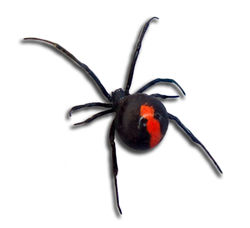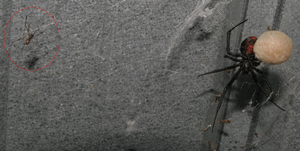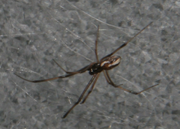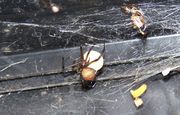Redback spider
| Redback spider | |
|---|---|
 |
|
| Female Redback spider | |
| Scientific classification | |
| Kingdom: | Animalia |
| Phylum: | Arthropoda |
| Class: | Arachnida |
| Order: | Araneae |
| Family: | Theridiidae |
| Genus: | Latrodectus |
| Species: | L. hasselti |
| Binomial name | |
| Latrodectus hasselti Thorell, 1870 |
|
The Redback spider (Latrodectus hasselti) is a potentially dangerous spider native to Australia that resembles a Black widow spider. It is a member of the genus Latrodectus or the widow family of spiders, which are found throughout the world. The female is easily recognisable by its black body with prominent red stripe on the upper side (i.e. the back) of its abdomen. Females have a body length of about a centimetre while the male is smaller, being only 3 to 4 millimetres long. The Redback spider is one of few arachnids which display sexual cannibalism while mating.
Redbacks are considered one of the most dangerous spiders in Australia.[1] The Redback spider has a neurotoxic venom which is toxic to humans with bites causing severe pain. There is an antivenom for Redback bites which is commercially available.
Contents |
Taxonomy
The Redback spider is a member of the spider genus Latrodectus, in the family Theridiidae. It is related to the best known member of the group, the black widow spider (Latrodectus mactans) found in North America and other regions. Close relatives of the Redback are the katipo (Latrodectus katipo), which is native to New Zealand. The common name of "Redback " is derived from its distinctive red stripe along the dorsal aspect of its abdomen. Other common names include Jockey spider, Murra-ngura spider, Kapara spider and the Kanna-jeri spider.[2]
The species was named in honour of A.W.M. van Hasselt, a colleague of the author, Tamerlan Thorell, who described it in 1870.[3][4]
Physical description

The female Redback has a round body about the size of a large pea (1 centimetre long), with long, slender legs. The body is a deep black colour (occasionally brownish), often containing an obvious orange to red longitudinal stripe on the upper abdomen. The stripe is sometimes broken or looks like small red dots. On the underside of the abdomen there is an "hourglass" shaped red/orange spot. Juvenile spiders have additional white markings on the abdomen. The male Redback is three to four millimetres long and is light brown in colour with white markings on the upper side of the abdomen and a pale hour-glass marking on the underside.[5]
Ecology and behaviour
Web
The Redback web is a disorganised, irregular tangle of fine but strong silk. The rear portion of the web forms a funnel-like retreat area where the spider and egg sacs are found. This area has vertical, sticky catching threads that run to ground attachments.[5][6] The vertical strands serve two purposes, it snares prey and small insects can be potentially lifted in the air like a bungee cord, and second the acts as a trip wire to alerts the spider to the presence of prey.[7][8]
Prey


Redbacks usually prey on insects but they can capture larger animals that become entangled in the web including king crickets, trapdoor spiders, and small lizards.[9] Commonly prey stealing occurs where larger females take food items stored in other spiders' webs.[5] Most commonly, ants stray into the web.[10]
Life cycle
Male spiders mature in 37 to 167 days (average in about 90 days). Females mature in 60 to 325 days (average in about four months). Males live for up to 6 or 7 months while female may live for between 2 and 3 years. Even without food spiders may survive for an average of 100 days.[9]
Reproduction
The Redback spider is one of only two animals to date where the male has been found to actively assist the female in sexual cannibalism. In the process of mating, the much smaller male somersaults to place his abdomen over the female's mouthparts. In about 2 out of 3 cases, the female consumes the male while mating continues. Males who are not eaten die soon after mating.
Males who sacrifice themselves during mating present two advantages over males who do not. The first is that males who are eaten are able to copulate for a longer period and thus fertilise more eggs. The second is that females who have eaten a male are more likely to reject subsequent males.[11]
Some Redback males have been observed utilising an alternative tactic that also ensures that more of their genetic material is passed on. Juvenile female Redbacks who are nearing their final moulting and adulthood have fully formed reproductive organs but lack openings in the exoskeleton that allow access to the organs. Males will bite through the exoskeleton and deliver sperm to the organs without performing the somersault seen in males mating with adult females. The females then moult within a few days and deliver a normal clutch of eggs.[12]
Once the female has mated, she can store sperm and use it over a period of up to two years to lay several batches of eggs. A female spider may lay eggs every 25 to 30 days. A single female normally lays between 40 and 300 eggs in each sac but can lay up to 5000 eggs. The eggs hatch 13 to 15 days after being laid. Young Redback spiders leave the maternal web by being carried on the wind. The spider extends its abdomen high in the air and produces a droplet of silk. The liquid silk is drawn out into a long thread that, when long enough, carries the spider away. Eventually the silken thread will adhere to an object where the young spider will establish its own web.[9]
Distribution

Its origins are uncertain, and it may have been spread by human activities during the 19th century. Redback spiders are now found in all but the most inhospitable environments in Australia. The Redback spider is commonly found in close proximity to human residences. Webs are usually built in dry, sheltered sites, such as among rocks, in logs, shrubs, old tyres, sheds, outhouses, children's toys or under rubbish or litter.[5]
The wide distribution range of the related species Latrodectus geometricus, the brown widow, includes Brisbane, Australia.
Introductions
Media in Japan have reported the discovery of Redback spiders in Osaka, Japan within a hundred kilometres of Kansai International Airport. It was speculated that they arrived in Japan by "hitching" a ride on the outside of airliners, or carried in cargoes of wood chips.[13] In 2008, Redback spiders were found in Fukuoka, Japan. Over 700 have been found near the container terminal in Hakata Bay, Fukuoka city. Warning signs about Redback spiders have been posted in parks around the city as Japan has had no dangerous venomous spiders before now. This has lead to confusion in Japan since the native spider Latrodectus elegans is also commonly known as the redback spider.
Redback spiders are also found in small colonies in areas of New Zealand. These spiders were imported on Australian hardwood poles used for electric power and telephone. They are found around Central Otago in the South Island and New Plymouth in the North Island.[14]
Tourist Guides in UAE warn visitors of Redback spiders[15].
Redback Spiders have been found in the UK after a container of parts from Austraila arrived in Preston Lancashire it is possible some escaped into the countryside before pest controllers could destroy them. [16]
Toxicology
Venom is produced by glands in the cephalothorax, and expelled venom travels through paired ducts from the cephalothorax, exiting through the tip of the spider's hollow fangs. The venom of the Redback spider is thought to be similar to other Latrodectus spiders and contains a number of high molecular weight proteins, one of which, alpha-latrotoxin (a neurotoxin), is active in humans. In vertebrates alpha-latrotoxin produces its effect through destabilization of cell membranes and degranulation of nerve terminals resulting in the release of neuro-transmitters; it causes uncontrolled release of the neurotransmitters acetylcholine, norephedrine, and GABA. The release of these neurotransmitters leads to the clinical manifestations of envenomation.[17]
Bites in humans
Redback spider bites rarely cause significant morbidity, and deaths are even more rare[18]. On Australian record only 14 deaths from redbacks have been recorded. [19][20] A significant proportion of bites will not result in envenomation or any symptoms developing. It is believed that thousands of people are bitten each year across Australia, although only about 20% of bite victims require treatment.[21] Children and the elderly or those with serious medical conditions are at much higher risk of severe side-effects and death resulting from a bite. No deaths have been reported since the introduction of antivenom in 1956.[22]
The larger female spider is responsible for almost all cases of Redback spider bites in humans. The smaller male spider was thought to be unable to envenomate a human; however, male bites have occurred. The rarity of male bites is probably due to smaller size and proportionally smaller fangs rather than the male being incapable of biting or lacking venom of potency similar to the female's. Cases have shown that the male bite usually only produces short-lived, mild pain.[18]
Most bites occur in the warmer months between December and April and in the afternoon or evening.[18][23] As the female Redback is slow moving and rarely leaves its web, bites generally occur as a result of a person placing a hand or other body part too close to the web, such as reaching into dark holes or wall cavities. But bites can occur wherever the spider may gain access, such as when putting on shoes or dressing.[17]
Symptoms
Bites from Redback spiders produce a syndrome known as latrodectism. The symptoms are similar to bites from other Latrodectus spiders. The syndrome is generally characterised by extreme pain and severe sweating.[24] Initially the bite may be painful but sometimes only feels like a pin prick or mild burning sensation. Within an hour victims generally develop more severe local pain with local sweating and sometimes piloerection (goosebumps). Pain, swelling and redness spread proximally from the site. Systemic envenoming is heralded by swollen or tender regional lymph nodes; associated features include malaise, nausea, vomiting, abdominal or chest pain, generalised sweating, headache, fever, hypertension and tremor.[17][18] Rare complications include seizure, coma, pulmonary edema, respiratory failure or localised skin infection.[23] Severe pain can persist for over 24 hours after being bitten.[25]
Treatment
Medical advice should be sought after being bitten by a Redback spider. Usually this requires observation in or near a medical facility for six hours from time of the bite.[17] Treatment is based on the severity of the bite; patients with localised pain, swelling and redness usually do not require any specific treatment apart from applying ice and routine analgesics. In more severe bites the definitive treatment consists of administering Redback antivenom. Antivenom will usually give immediate relief to symptoms of systemic envenoming.
Antivenom is indicated in anyone suffering symptoms consistent with Latrodectus envenoming. Particular indications for using antivenom are:
- Pain and swelling spreading proximally from site
- Chest pain
- Abdominal pain
- Unusual sweating
Currently it is recommended that this antivenom be given intramuscularly(IM) rather than intravenously(IV), although some have suggested that IM antivenom is not as effective as IV antivenom.[18][26] Adverse reactions to Redback antivenom are rare[27] and antivenom may be effective for up to 3 months after a bite.[28] Doses are the same for both children and adults.
References
- ↑ Dangerous Spiders, Australian Museum web site
- ↑ Platnick N, Merrett p, Brignoli PM, ed (1990). Advances in spider taxonomy, 1981-1987. A supplement to Brignoli’s “a catalogue of the Araneae described between 1940-1981. Manchester University Press. ISBN 0719027829.
- ↑ Australian Biological Resources Study. "Species bank: Latrodectus hasseltii". http://www.environment.gov.au/cgi-bin/species-bank/sbank-treatment.pl?id=69198. Retrieved 2007-01-27.
- ↑ Thorell, T. 1870. Araneae nonnullae Novae Hollandie, descriptae. Öfvers. Kongl. vet. Akad. Förh. 27: 367-389. [369]
- ↑ 5.0 5.1 5.2 5.3 Australian Museum. "Redback Spider Fact Sheet". http://www.amonline.net.au/factsheets/Redback.htm. Retrieved 2007-02-18.
- ↑ Queensland Museum. "Identifying the Redback". http://www.qm.qld.gov.au/features/spiders/Redback-id.asp. Retrieved 2007-02-18.
- ↑ [1]
- ↑ [2]
- ↑ 9.0 9.1 9.2 Queensland Museum. "Redback Habitat and Life Cycle". http://www.qm.qld.gov.au/features/spiders/Redback-habitat.asp. Retrieved 2007-02-18.
- ↑ [3]
- ↑ Andrade, Maydianne C. B. (5 January 1996). "Sexual Selection for Male Sacrifice in the Australian Redback Spider". Science 271 (5245): 70–2. doi:10.1126/science.271.5245.70. http://www.sciencemag.org/cgi/content/abstract/271/5245/70. Retrieved 2007-01-15.
- ↑ Biaggio, M.D., and M.C.B. Andrade (August 12-16, 2006). "Breaking an entry: Male Redback spiders inseminate juvenile females by ripping through their exoskeleton". Animal Behaviour Society meeting.
- ↑ Victoria Museum. "Redback Spider". http://www.museum.vic.gov.au/spidersparlour/spider13.htm. Retrieved 2007-02-18.
- ↑ Reed C, Newland S, Downs, J, Forbes V, Gilbert S (September 2002) (PDF). MAF Biosecurity Pest Risk Assessment: Spiders Associated With Table Grapes From United States of America (State of California), Australia, Mexico and Chile. MAF Biosecurity. http://www.biosecurity.govt.nz/files/regs/imports/risk/spiders-grapes-ra.pdf. Retrieved 2007-02-18.
- ↑ http://archive.gulfnews.com/nation/General/10318145.html
- ↑ Metro. "Deadly Australian spiders 'invading' the UK, one field at a time". http://www.metro.co.uk/weird/832600-deadly-australian-spiders-invading-the-uk-one-step-at-a-time. Retrieved 2010-06024.
- ↑ 17.0 17.1 17.2 17.3 Meier J, White J, ed (1995). Handbook of clinical toxicology of animal venoms and poisons. CRC Press. ISBN 0-8493-4489-1.
- ↑ 18.0 18.1 18.2 18.3 18.4 Isbister G, Gray M (2003). "Latrodectism: a prospective cohort study of bites by formally identified Redback spiders". Med J Aust 179 (2): 88–91. PMID 12864719.
- ↑ http://www.avru.org/compendium/biogs/A000006b.htm Australian Venom Research Unit - Redback Spiders
- ↑ Carol Booth (2009). "Along Came A Spider". Australian Geographic. http://www.australiangeographic.com.au/journal/along-came-a-spider.htm
- ↑ White J (1998). "Envenoming and antivenom use in Australia". Toxicon 36 (11): 1483–92. doi:10.1016/S0041-0101(98)00138-X. PMID 9792162.
- ↑ Wiener S (2003). "Latrodectism: a prospective cohort study of bites by formally identified Redback spiders". Med J Aust 179 (8): 455; author 455–6. PMID 14558881.
- ↑ 23.0 23.1 Sutherland S, Trinca J (1978). "Survey of 2144 cases of Redback spider bites: Australia and New Zealand, 1963--1976". Med J Aust 2 (14): 620–3. PMID 732670.
- ↑ Redback Spider Facts
- ↑ A prospective study of 750 definite spider bites, with expert spider identification - Isbister and Gray 95 (11): 723 - QJM
- ↑ Isbister G (2002). "Failure of intramuscular antivenom in Redback spider envenoming". Emerg Med (Fremantle) 14 (4): 436–9. doi:10.1046/j.1442-2026.2002.00356.x. PMID 12534488.
- ↑ White J. "CSL antivenom handbook". http://www.toxinology.com/generic_static_files/cslb_index.html. Retrieved 2007-02-18.
- ↑ Banham N, Jelinek G, Finch P (1994). "Late treatment with antivenom in prolonged Redback spider envenomation". Med J Aust 161 (6): 379–81. PMID 8090117.
External links
 Media related to Latrodectus hasselti at Wikimedia Commons
Media related to Latrodectus hasselti at Wikimedia Commons
 Data related to Latrodectus hasselti at Wikispecies
Data related to Latrodectus hasselti at Wikispecies- Australian Museum
- Rochedale State School
- Queensland Museum
- University of Toronto
- Description, distribution, pictures (Australian Government: Department of the Environment and Heritage)
- Spinnenkenners vrezen dat er toch dodelijke Redbacks in Bree overleven (Belgian Redbacks in Bree, in Dutch)